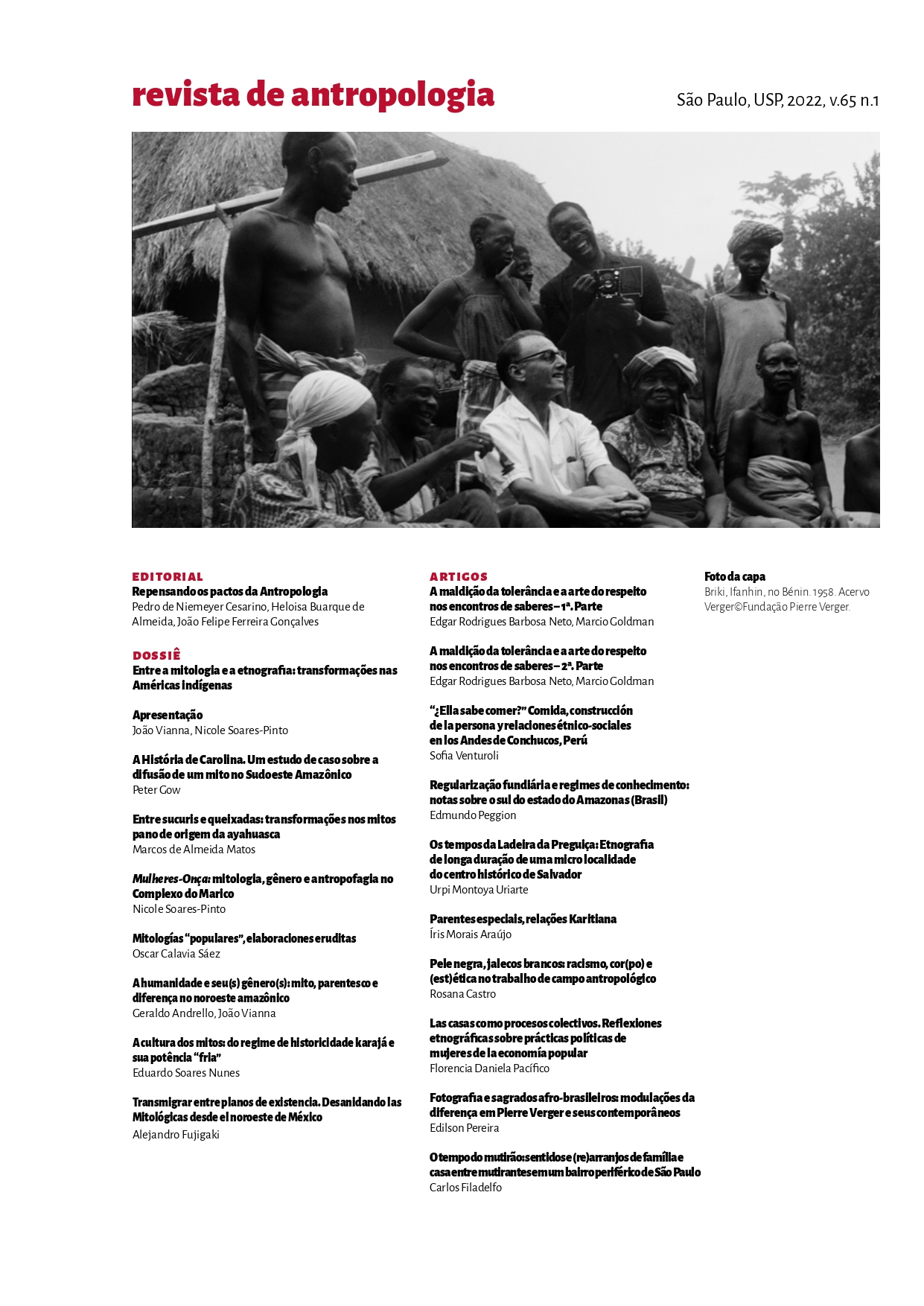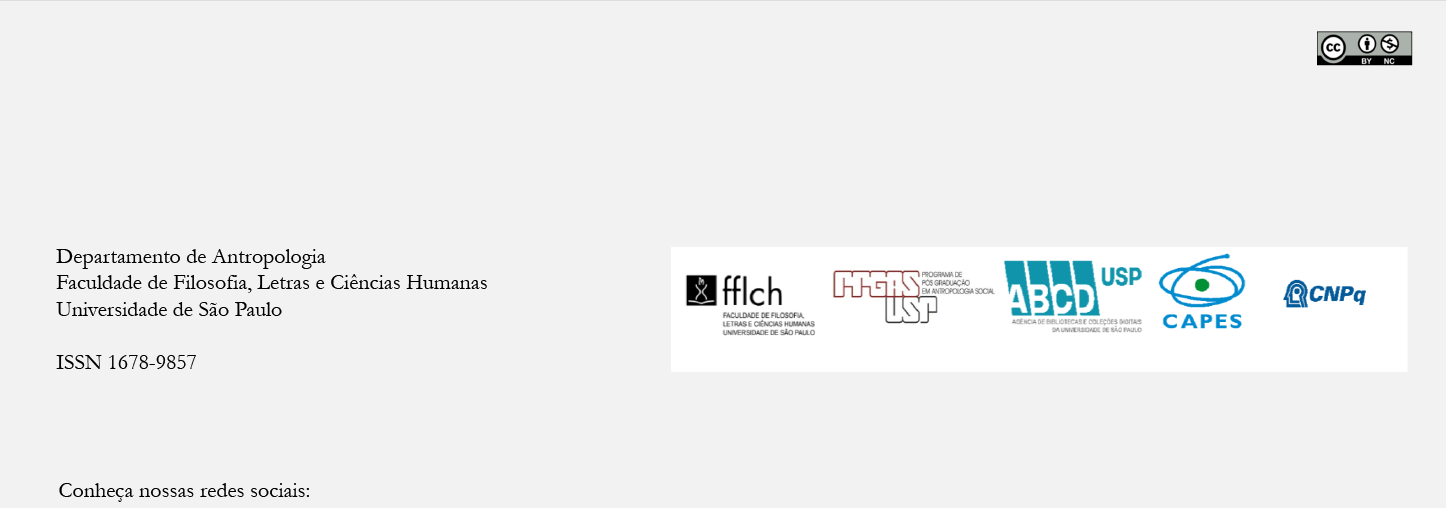A História de Carolina. Um estudo de caso sobre a difusão de um mito no Sudoeste Amazônico
DOI:
https://doi.org/10.11606/1678-9857.ra.2022.192829Palavras-chave:
Ensemble, Mitologia, Incesto, História, LuaResumo
Um povo pode desaparecer, mas não uma história. Isso foi o que ocorreu com um mito kuniba, narrado a Nimuendaju por Carolina, em uma situação de remoção forçada promovida pelo Estado brasileiro no começo do século XX. O mito em questão falava da origem da lua, ocasionada pelo incesto de um irmão com uma irmã. Até o começo do século XX, povos vizinhos dos Kuniba, como os Cashinahua e os Kanamari, tinham narrativas muito distintas sobre a origem da lua. No entanto, ao longo do século, com a partida dos Kuniba, o tema do incesto entre irmão e irmã passa a estar presente nas narrativas, difundindo-se pela região das bacias dos rios Juruá e Purus. Isso conduz a uma reflexão sobre o problema da “causalidade informacional”, sobre a “política externa” estabelecida entre diferentes povos e sobre a “dialética espacial” promovida pelos mitos.
Downloads
Referências
ABREU, João Capistrano de. 1941 Rã-txa hu-ni-ku-i: Grammatica, textos e vocabulário Caxinauás. Edição da Sociedade Capistrano de Abreu.
CARVALHO, Maria Rosario Gonçalves de. 2002 Os Kanamari da Amazônia Ocidental. História, mitologia, ritual e xamanismo. Salvador: Ed. Casa de Palavras.
CHANDLESS, William. 1986 “Notes of a Journey up the River Juruá”. Journal of the Royal Geographical Society of London, Vol. 39: 296-311.
COSTA, Luiz. 2007 As Faces do Jaguar: Parentesco, História e Mitologia entre os Kanamari da Amazônia Ocidental. Tese defendida no Programa de Pós-Graduação em Antropologia Social do Museu Nacional, Rio de Janeiro.
CUNHA, Euclydes da. 1907 Peru versus Bolívia. Rio de Janeiro, Livraria Francisco Alves.
DESHAYES, Patrick; KEIFENHEIM, Barbara. 2003 Pensar el Otro entre los Huni Kuin de la Amazonía Peruana. Trad. Balbina Vallejo. Lima: CAAAP.
LÉVI-STRAUSS, Claude. 1949 [2019] “La politique étrangère d’une societé primitive”. In: Anthropologie Structurale Zéro. Vicent Debaene (ed.). Paris: Éditions du Seuil: 201-219.
LÉVI-STRAUSS, Claude. 1964 [2004] Mitológicas: O Cru e o Cozido. Trad. Beatriz Perrone-Moisés. São Paulo: Cosac & Naify.
LÉVI-STRAUSS, Claude. 1968 [2006] Mitológicas: A origem dos modos à mesa. Trad. Beatriz Perrone-Moisés. São Paulo: Cosac & Naify.
LÉVI-STRAUSS, Claude. 1971 [2011] Mitológicas: O homem nu. Trad. Beatriz Perrone-Moisés. São Paulo: Cosac & Naify.
MCCALLUM, Cecilia. 2001 Gender and Sociality in Amazonia. How real people are made. Oxford: Berg.
MUNN, Nancy. 1973 Walbiri Iconography: Graphic Representation and Cultural Symbolism in a Central Australian Society. Ithaca: Cornell University Press.
NIMUENDAJU, Curt. 1986 “Mitos Indígenas na Obra de Curt Nimuendaju”. Revista do Patrimônio Histórico e Artístico Nacional. n. 21: 64-111.
SASS, Walter (org.). 2007 Tâkuna. Nawa Bûh Amteiyam Amkira. Mitos Kanamari. São Leopoldo: Ed. Oikos & COMIN.
TASTEVIN, Constant; RIVET, Paul. 1923/1924 “Les langues du Purús, du Juruá et des régions limitrophes. Io Le groupe arawak pré-andin (Fin)”. Anthropos, Bd. 18/19, H. 1./3.: 104-113.
VIVEIROS DE CASTRO, Eduardo. 2001 “GUT feelings about Amazonia: potential affinity and the construction of sociality”. In: Laura Rival e Neil Whitehead (eds), Beyond the visible and the material. The Amerindianization of society in the work of Peter Rivière. Oxford: Oxford University Press: 19-43.
VIVEIROS DE CASTRO, Eduardo. 2002 A inconstância da alma selvagem e outros ensaios de antropologia. São Paulo: Cosac & Naify.
Downloads
Publicado
Edição
Seção
Licença
Copyright (c) 2022 Revista de Antropologia

Este trabalho está licenciado sob uma licença Creative Commons Attribution 4.0 International License.
Autores que publicam na Revista de Antropologia concordam com os seguintes termos:
a) Autores mantém os direitos autorais e concedem à revista o direito de primeira publicação, com o trabalho simultaneamente licenciado sob a Licença Creative Commons Attribution que permite o compartilhamento do trabalho com reconhecimento da autoria e publicação inicial nesta revista.
b) Autores têm autorização para assumir contratos adicionais separadamente, para distribuição não-exclusiva da versão do trabalho publicada nesta revista (ex.: publicar em repositório institucional ou como capítulo de livro), com reconhecimento de autoria e publicação inicial nesta revista.
c) Autores têm permissão e são estimulados a publicar e distribuir seu trabalho online (ex.: em repositórios institucionais ou na sua página pessoal) após o processo editorial, já que isso pode gerar alterações produtivas, bem como aumentar o impacto e a citação do trabalho publicado (Veja O Efeito do Acesso Livre).




